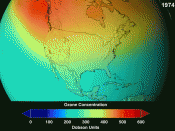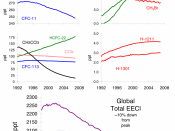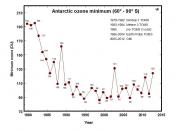The ozone hole over the Antarctic this year caught many people's attention since it was reported that it had reached record size. Many people hear these stats and really don't know what they exactly mean, they know that it can't be a good thing but what does it actually mean for them? In my paper I will explain the process and causes of the depletion itself, what does this depletion means to humans and plants, and what can be done if anything to prevent further damage.
The ozone depletion process begins when CFCs and other ozone depleting substances (ODS) are emitted into the atmosphere. Winds efficiently mix the troposphere and evenly distribute the gases. CFCs are extremely stable, and they do not dissolve in rain (Haas 2001). So, after a period of time theses CFCs, which contain Chlorine, reach the stratosphere and begin to destroy the ozone (Haas 2001).
So, what are CFCs? Manmade CFCs compounds were developed in the early 1930s for a variety of industrial and commercial applications, but it was not until the 1970s that these and other chlorine-containing substances were suspected of having the potential to destroy atmospheric ozone (Haas 2001). In 1985 a team of British researchers first reported unusually low ozone levels over Halley Bay, Antarctica, which was caused by chemical reactions with chlorine and nitrogen compounds. Research was initiated that found CFCs to be largely responsible for the anomalously low levels during the polar springtime. This polar ozone depletion at lower stratospheric altitudes is what has been termed the "ozone hole" (Rycroft 1990).
Since, we now know what causes this ozone depletion, what does this mean in terms of humans and plants? The potential impact on human health and ecosystems due to increased UV exposure is a primary concern. Increases in...


